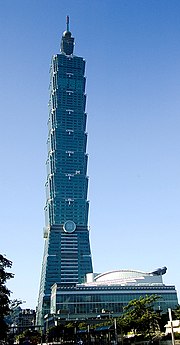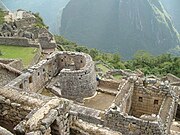Earthquake engineering is the study of the behavior of buildings and structures subject to seismic loading. It is a subset of both structural and civil engineering. Eminent authority on seismic risk mitigation, Caltech professor George W. Housner is widely considered as the 'father' of the modern field of earthquake engineering. Stanford University professor John Blume’s contributions to the dynamics of structures have earned him the title of the 'father' of earthquake engineering too.
The main objectives of earthquake engineering are:
- Understand the interaction between buildings or civil infrastructure and the ground.
- Foresee the potential consequences of strong earthquakes on urban areas and civil infrastructure.
- Design, construct and maintain structures to perform at earthquake exposure up to the expectations and in compliance with building codes[1].
A properly engineered structure does not necessarily have to be extremely strong or expensive.


The most powerful and budgetary tools of earthquake engineering are vibration control technologies and, in particular, base isolation.
Contents[hide] |
Seismic loading
Seismic loading means application of an earthquake-generated agitation to a structure. It happens at contact surfaces of a structure either with the ground [11], or with adjacent structures [12], or with gravity waves from tsunami. Seismic loading depends, primarily, on:
- Anticipated earthquake's parameters at the site
- Geotechnical parameters of the site
- Structure's parameters
- Characteristics of the anticipated gravity waves from tsunami (if applicable).
Ancient builders believed that earthquakes were a result of wrath of Gods (in Greek mythology, e.g., the main "Earth-Shaker" was Poseidon) and, therefore, could not be resisted by humans. Nowadays, the people's attitude has changed dramatically though the seismic loads, sometimes, exceed ability of a structure to resist them without being broken, partially or completely.
Due to their mutual interaction, seismic loading and seismic performance of a structure are intimately related.
Seismic performance
Earthquake or seismic performance is an execution of a building's or structure's ability to sustain their due functions, such as its safety and serviceability, at and after a particular earthquake exposure. A structure is, normally, considered safe if it does not endanger the lives and wellbeing of those in or around it by partially or completely collapsing. A structure may be considered serviceable if it is able to fulfill its operational functions for which it was designed.
Basic concepts of the earthquake engineering, implemented in the major building codes, assume that a building should survive The Big One (the most powerful anticipated earthquake) though with partial destruction [2].
Seismic performance evaluation
Engineers need to know the quantified level of an actual or anticipated seismic performance associated with the direct damage to an individual building subject to a specified ground shaking.
The best way to do it is to put the structure on a shake-table that simulates the earth shaking and watch what may happen next [13]. Such kinds of experiments were performed still more than a century ago[3]
Another way is to evaluate the earthquake performance analytically.
Seismic performance analysis
Seismic performance analysis or, simply, seismic analysis is a major intellectual tool of earthquake engineering which breaks the complex topic into smaller parts to gain a better understanding of seismic performance of building and non-building structures. The technique as a formal concept is a relatively recent development.
In general, seismic analysis is based on the methods of structural dynamics[4]. For decades, the most prominent instrument of seismic analysis has been the earthquake response spectrum method which, also, contributed to the proposed building code's concept of today[5].
However, those spectra are good, mostly, for single-degree-of-freedom systems. Numerical step-by-step integration proved to be a more effective method of analysis for multi-degree-of-freedom structural systems with severe non-linearity under a substantially transient process of kinematic excitation[6].
Research for earthquake engineering
Research for earthquake engineering means both field and analytical investigation or experimentation intended for discovery and scientific explanation of earthquake engineering related facts, revision of conventional concepts in the light of new findings, and practical application of the developed theories. The National Science Foundation (NSF) is the main United States government agency that supports fundamental research and education in all fields of earthquake engineering. In particular, it focuses on experimental, analytical, and computational research on design and performance enhancement of structural systems.

The Earthquake Engineering Research Institute (EERI) is a leader in dissemination of earthquake engineering research related information both in the U.S. and globally.
A definitive list of earthquake engineering research related shaking tables around the world may be found in Experimental Facilities for Earthquake Engineering Simulation Worldwide. The most prominent of them is now E-Defense Shake Table [7] in Japan.
Major U.S. research programs
The NSF Hazard Mitigation and Structural Engineering program (HMSE) supports research on new technologies for improving the behavior and response of structural systems subject to earthquake hazards; fundamental research on safety and reliability of constructed systems; innovative developments in analysis and model based simulation of structural behavior and response including soil-structure interaction; design concepts that improve structure performance and flexibility; and application of new control techniques for structural systems [14].
NSF also supports George E. Brown, Jr. Network for Earthquake Engineering Simulation (NEES) [15] that advances knowledge discovery and innovation for earthquakes and tsunami loss reduction of the nation's civil infrastructure, and new experimental simulation techniques and instrumentation.

NEES [16] comprises a network of 15 earthquake engineering experimental equipment sites available for experimentation on-site or in the field and through telepresence. NEES equipment sites include shake-tables, geotechnical centrifuges, a tsunami wave basin, unique large-scale testing laboratory facilities, and mobile and permanently installed field equipment [17].
NEES Cyberinfrastructure Center (NEESit) connects, via Internet2, the equipment sites as well as provides telepresence, a curated central data repository, simulation tools, and collaborative tools for facilitating on-line planning, execution, and post-processing of experiments.
Earthquake simulation
The very first earthquake simulations were performed by statically applying some horizontal inertia forces based on scaled peak ground accelerations to a mathematical model of a building [8]. With the further development of computational technologies, static approaches began to give way to dynamic ones.
Dynamic experiments on building and non-building structures may be physical, like shake-table testing, or virtual ones. In both cases, to verify a structure's expected seismic performance, some researchers prefer to deal with so called "real time-histories" though the last cannot be "real" for a hypothetical earthquake specified by either a building code or by some particular research requirements. Therefore, there is a strong incentive to engage an earthquake simulation which is the seismic input that possesses only essential features of a real event.
Sometimes, earthquake simulation is understood as a re-creation of local effects of a strong earth shaking.
Structure simulation
Theoretical or experimental evaluation of anticipated seismic performance mostly requires a structure simulation which is based on the concept of structural likeness or similarity. Similarity is some degree of analogy or resemblance between two or more objects. The notion of similarity rests either on exact or approximate repetitions of patterns in the compared items.

In general, a building model is said to have similarity with the real object if the two share geometric similarity, kinematic similarity and dynamic similarity. The most vivid and effective type of similarity is the kinematic one. Kinematic similarity exists when the paths and velocities of moving particles of a model and its prototype are similar.
The ultimate level of kinematic similarity is kinematic equivalence when, in the case of earthquake engineering, time-histories of each story lateral displacements of the model and its prototype would be the same.
Seismic vibration control
Seismic vibration control is a set of technical means aimed to mitigate seismic impacts in building and non-building structures. All seismic vibration control devices may be classified as passive, active or hybrid [18] where:
- passive control devices have no feedback capability between them, structural elements and the ground;
- active control devices incorporate real-time recoding instrumentation on the ground integrated with earthquake input processing equipment and actuators within the structure;
- hybrid control devices have combined features of active and passive control systems.[9]
When ground seismic waves reach up and start to penetrate a base of a building, their energy flow density, due to reflections, reduces dramatically: usually, up to 90%. However, the remaining portions of the incident waves during a major earthquake still bear a huge devastating potential.
After the seismic waves enter a superstructure, there are a number of ways to control them in order to soothe their damaging effect and improve the building's seismic performance, for instance:
- to dissipate the wave energy inside a superstructure with properly engineered dampers;
- to disperse the wave energy between a wider range of frequencies;
- to absorb the resonant portions of the whole wave frequencies band with the help of so called mass dampers [19].
Devices of the last kind, abbreviated correspondingly as TMD for the tuned (passive), as AMD for the active, and as HMD for the hybrid mass dampers, have been studied and installed in high-rise buildings, predominantly in Japan, for a quarter of a century [20].
However, there is quite another approach: partial suppression of the seismic energy flow into the superstructure known as seismic or base isolation.
For this, some pads are inserted into or under all major load-carrying elements in the base of the building which should substantially decouple a superstructure from its substructure resting on a shaking ground.
The first evidence of earthquake protection by using the principle of base isolation was discovered in Pasargadae, a city in ancient Persia, now Iran: it goes back to VI century BC. Below, there are some samples of seismic vibration control technologies of today.
Dry-stone walls control
People of Inca civilization were masters of the polished dry-stone walls, called ashlar, where blocks of stone were cut to fit together tightly without any mortar. The Incas were among the best stone masons the world has ever seen [10], and many junctions in their masonry were so perfect that even blades of grass could not fit between the stones.
Peru is a highly seismic land, and for centuries the mortar-free construction proved to be apparently more earthquake-resistant than using mortar. The stones of the dry-stone walls built by the Incas could move slightly and resettle without the walls collapsing which should be recognized as an ingenious passive structural control technique employing both the principle of energy dissipation and that of suppressing resonant amplifications [11].
Lead Rubber Bearing

Lead Rubber Bearing or LRB is a type of base isolation employing a heavy damping.
Heavy damping mechanism incorporated in vibration control technologies and, particularly, in base isolation devices, is often considered a valuable source of suppressing vibrations thus enhancing a building's seismic performance. However, for the rather pliant systems such as base isolated structures, with a relatively low bearing stiffness but with an high damping, the so-called "damping force" may turn out the main pushing force at a strong earthquake. The video [21] shows a Lead Rubber Bearing being tested at the UCSD Caltrans-SRMD facility. The bearing is made of rubber with a lead core. It was a uniaxial test in which the bearing was also under a full structure load.
Tuned mass damper
Typically, the tuned mass dampers are huge concrete blocks mounted in skyscrapers or other structures and moved in opposition to the resonance frequency oscillations of the structures by means of some sort of spring mechanism.
Taipei 101 skyscraper needs to withstand typhoon winds and earthquake tremors common in its area of the Asia-Pacific. For this purpose, a steel pendulum weighing 660 metric tons that serves as a tuned mass damper was designed and installed atop the structure. Suspended from the 92nd to the 88th floor, the pendulum sways to decrease resonant amplifications of lateral displacements in the building caused by earthquakes and strong gusts.







0 comments:
Post a Comment